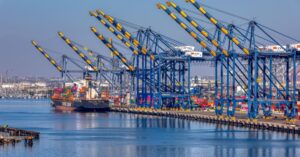The complexities of transportation logistics are many-faceted. For starters, meeting rising customer expectations across multiple sales channels (online, store and wholesale, marketplaces, drop shipping, etc.) requires seamless integration and coordination of inventory and fulfillment processes.
Demand for real-time visibility, including status updates, requires the latest inventory management technology and tight partner integration. Expand your business cross-border to other countries, and the inventory and fulfillment challenges multiply.
Getting fulfillment logistics right means balancing inventory levels to meet demand while minimizing holding costs and avoiding stockouts. There are also demand fluctuations to consider, due to seasonality, trends, promotions, or unforeseen events, requiring an agile inventory strategy.
As you execute your fulfillment and logistics operations, each decision and tactic employed impacts not only costs but also the overall customer experience. All of this requires a good deal of orchestration to deliver against goals and forecasts while being mindful of bottom-line impact. Key metrics like average cost per order and average order fulfillment time must be watched closely to ensure operational efficiency is being maintained.
While there has been a bit of a falloff in ecommerce growth after the pandemic explosion, research data compiled by Statista still projects it will achieve a healthy compound annual growth rate of about 9% between 2024 and 2028. That means shippers will continue to face challenges maintaining commitments as fulfillment becomes more complex and shipping costs rise.
For these reasons, more and more companies are forging partnerships with third-party logistics providers (3PL). They’re realizing that fulfillment and shipping demands will continue to outstrip their internal capabilities, and a capable 3PL solution is needed in order to bridge the gap.
While cost is certainly critical, the vast majority of shippers consider service level more important when choosing or maintaining a 3PL partnership. According to a 2023 survey by Inbound Logistics, 81% of shippers said service was the number-one consideration in a 3PL partnership, compared to just 19% for cost.
Exploring the Diverse Complexities in Logistics
The level of coordination and orchestration required in logistics are considerable, with each aspect touching all others. Here are some examples:
Navigating Global Trade Regulations
Different countries impose tariffs and trade barriers, impacting the cost of importing/exporting goods and influencing pricing strategies. Customs duties and taxes add complexity to cross-border logistics, affecting costs and shipping times.
Each country has its own set of regulations for imports/exports. Also, compliance with various product standards, certifications, and labeling requirements poses challenges for shippers.
Trade agreements and treaties all affect tariffs and quotas for cross-border trade. Shifts in geopolitical tensions lead to sudden regulatory changes.
Customs documentation, certificates of origin, export/import licenses, and other paperwork are time-consuming and demand meticulous attention to detail. Compliance with export controls and sanctions imposed on specific countries or entities can restrict or complicate the shipping of certain goods.
Compliance-related delays at customs checkpoints can lead to long shipping times. And changes in trade policies or sudden regulatory shifts can also affect sourcing, transportation, and delivery timelines.
Technology Integration in Supply Chain and Logistics
Integrating technology into logistics and supply chain operations is essential for shippers to improve efficiency, visibility, and overall performance. But, several issues need to be addressed.
Many shippers use a mix of legacy systems and enterprise software such as ERP and CRM. Using API connections is the quickest, easiest route to system integration, as well as middleware and data mapping, while EDI and XML can also facilitate data exchange. Engaging with an experienced system integrator or consultant is highly recommended for these kinds of projects.
To enhance visibility across the supply chain, an Internet of Things (IoT) solution or RFID and GPS tracking can provide real-time data on shipment locations and conditions. This data can be integrated into your ERP to facilitate decision-making and reporting.
Accurate demand forecasting and inventory management are crucial, but these processes can be complex. Advanced artificial intelligence and machine learning use predictive analytics to inform real-time adjustments and improve optimization.
Modern warehouse management systems (WMS) and warehouse control systems (WCS) are also integrated with ERP to streamline fulfillment and logistics operations. Likewise, automated systems like receiving/picking robots and automated storage and retrieval (AS/RS) can also share data with enterprise systems to improve efficiency.
Coordinating transportation modes and carriers can be complex. A transportation management system (TMS) integrated with your ERP and order management system (OMS) can optimize carrier routes and costs. Other tools like telematics and GPS provide real-time vehicle tracking if you use your own fleet.
Demand Fluctuations and Inventory Adaptability
As the past few years have amply demonstrated, there are demand fluctuations – and then there are demand fluctuations! While certainly not on the scale of a global pandemic, there is always a raft of potential disruptors waiting in the wings.
This type of above-average demand variability has made life interesting for inventory management teams. One response has been a rise in reshoring and nearshoring strategies by companies that source inventory from overseas, primarily in Asia. According to the Inbound Logistics report, 53% of respondent shippers were sourcing products closer to home in 2023, up from 43% in the prior year.
In a related trend, 52% of respondents said they were seeking to optimize inventory management via strategic sourcing. This involves consolidating purchasing power to optimize inventory spend, aligning it more closely with business goals.
Again, AI and machine learning powering not only predictive analytics but even prescriptive analytics, putting more intelligence muscle and automation behind inventory management and purchase decisions.
Coordinating Multi-Modal Transportation
Booking multi-modal transportation involves several logistics processes to ensure shipping across ocean and air freight, as well as trucking modes. In addition to managing customs clearance at port, shippers need to engage with a mix of carriers and freight forwarders along each stage.
A good deal of logistical coordination is involved in consolidating multiple shipments at debarkation for efficiency, and deconsolidation at port for distribution to final destination.
On the cost management side, shippers – either on their own or through a 3PL or forwarder – must track transportation costs across carriers, including invoice verification and reconciliation, to ensure accurate billing and cost allocation.
Shippers must also deal with exception handling and implement contingency plans to minimize disruptions caused by delays or mis-shipments. Facilitating communication and collaboration among the various parties to ensure smooth product flow requires an expert hand.
Lastly, data analytics can be used to gain insights into multi-modal performance to identify areas for improvement and generate reports for management and stakeholders.
The Intersection of Protection, Compliance, and Efficiency
In freight shipping, there are a few different priorities in play. Obviously, goods have to be protected in transit, which means ensuring adequate protective packaging and proper handling. At the same time, regulatory compliance is always in view. And keeping operations running smoothly and efficiently is an overarching theme.
Shippers, and their 3PL partners, need to find ways to balance all of these priorities, without giving short shrift to any of them. And there are places where they naturally intersect. For example, the International Air Transport Association (IATA) has regulations that cover the safe handling and packaging of dangerous goods, perishables, and fragile items. In addition, countries and regions have their own regulations governing packaging and cargo handling that shippers and 3PLs must be aware of.
At this point, efficiency enters the picture to tie them all together. Without proper, compliant packaging and handling, shipments can get held up by regulatory inspectors, causing delays and negatively impacting operational efficiency. So, in this way, shippers are incentivized to make sure all relevant rules and guidelines are followed.
3PLs: Simplifying and Solving Logistics Challenges
Because global logistics are inherently complex and difficult to manage, many shippers turn to a 3PL partner that is well-versed in all aspects of domestic and cross-border shipping. Look for a partner that offers best-in-class solutions and technology, to ensure orders flow and schedules are maintained.
Mastery Over Regulatory Compliance
A top 3PL provider is an expert in managing the complex web of international and country-specific trade regulations for your shipments. They’ll make sure all the proper paperwork is filed on time, and keep up to date on all the latest changes and active dates.
Keeping on top of all regulatory requirements and filing all necessary paperwork can be a full-time job requiring an expert hand. Penalties for non-compliance include fines or even seizure of goods. An experienced 3PL can take the worry out of the complex tangle of international and country-specific regulations and standards.
Cutting-Edge Technology to Drive Efficiency
As 3PLs handle logistics for a variety of companies, they often invest in advanced technology to streamline and optimize operations at scale. These include things like fulfillment automation, pick to voice and pick to light, robotics, AS/RS, and a dashboard view into data analytics for monitoring and reporting.
Agile Management Strategies
An experienced 3PL partner needs to be adaptable and flexible to manage changing requirements. For example, demand fluctuates due to seasonality and other factors, such as new product launches or rapid growth. Your 3PL should have a demonstrated ability to quickly and efficiently scale up and down as conditions warrant.
Streamlining Multi-Faceted Transportation
A 3PL can offer multimodal transportation across road, rail, sea, and air to optimize the shipping process. They can determine the most cost-effective, efficient combination of modes based on the nature of your cargo, its destination, and time constraints. 3PLs have established carrier relationships and can negotiate favorable rates, ensuring cost savings and reliable service.
Robust Security and Product Safety Measures
3PLs play a crucial role in ensuring product safety and security during fulfillment and international shipping. They employ a variety of strategies and practices to minimize the risk of damage, loss, theft, or tampering. These include secure warehouse facilities, advanced inventory management, real-time supply chain visibility, and quality control and inspections.
Let COGISTICS Transportation Handle Managing Your Needs
With more than a quarter century of experience, COGISTICS Transportation offers a winning combination of agile, efficient operations, a mastery of regulatory requirements, and cutting-edge technology. It’s all built to provide you with a tailored, streamlined solution across land, sea, and air, whether domestic or international. Contact us today to get started.




